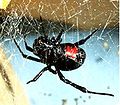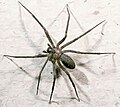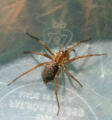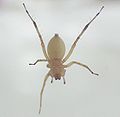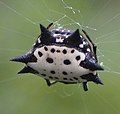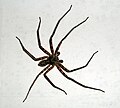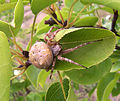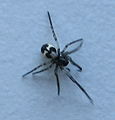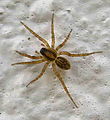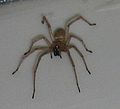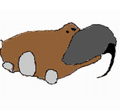Araneae
(Redirected from Araña)
- English: Spiders
- Afrikaans: Spinnekop
- Akan: Ananse
- Alemannisch: Webspinnen
- አማርኛ: ሸረሪት
- Ænglisc: Ātorcoppe
- Obolo: Olọnjin
- العربية: عنكبوت
- ܐܪܡܝܐ: ܓܘܓܝ
- مصرى: عنكبوت
- অসমীয়া: মকৰা
- Atikamekw: Ehepikw
- Aymar aru: Kusikusi
- azərbaycanca: Hörümçəklər
- تۆرکجه: تورآتان
- башҡортса: Үрмәкселәр
- Bikol Central: Lawa
- беларуская: Павукі
- беларуская (тарашкевіца): павукі
- български: Паяци
- Banjar: Kabibitak
- বাংলা: মাকড়সা
- brezhoneg: Kevnid
- bosanski: Pauk
- буряад: Абаахай
- català: Aranyes
- 閩東語 / Mìng-dĕ̤ng-ngṳ̄: Tĭ-tṳ̆
- нохчийн: Гезг
- Cebuano: Kaka
- ᏣᎳᎩ: ᎧᎿᏁᏍᎩ
- کوردی: جاڵجاڵۆکە
- Nēhiyawēwin / ᓀᐦᐃᔭᐍᐏᐣ: Ehepikw
- qırımtatarca: örümçek
- čeština: pavouci
- чӑвашла: Эрешмен
- Cymraeg: Corryn
- dansk: Edderkopper
- dagbanli: Kpatinariga
- Deutsch: Spinnen
- Schweizer Hochdeutsch: Webspinnen
- Thuɔŋjäŋ: Aɣukar
- Zazaki: Bındırık
- Kadazandusun: Korut
- eʋegbe: Ayiyi
- Ελληνικά: Αράχνες
- emiliàn e rumagnòl: Ragn
- Canadian English: Spider
- British English: spider
- Esperanto: Araneuloj
- español: Arañas
- eesti: Ämblikulised
- euskara: Armiarma
- فارسی: عنکبوت
- suomi: hämähäkit
- Na Vosa Vakaviti: Viritalawalawa
- føroyskt: Eiturkoppur
- français: Aranéides
- Nordfriisk: Wääbkoonkern
- Gaeilge: damhán alla
- Gàidhlig: Damhan-allaidh
- galego: Arañas
- Avañe'ẽ: Ñandu
- Alemannisch: Weebschpinne
- wayuunaiki: Walekerü
- 客家語 / Hak-kâ-ngî: Tî-tû
- עברית: עכבישאים
- हिन्दी: मकडी
- Fiji Hindi: Makrraa
- hrvatski: Pauci
- Kreyòl ayisyen: Areye
- magyar: Pókok
- հայերեն: Սարդեր
- Արեւմտահայերէն: Սարդ
- Bahasa Indonesia: Laba-laba
- Iñupiatun: Aasivak
- Ilokano: Lawwalawwa
- гӀалгӀай: Гизг
- Ido: Araneo
- íslenska: Köngulær
- italiano: Ragni
- ᐃᓄᒃᑎᑐᑦ / inuktitut: ᐋᓯᕙᖅ
- 日本語: クモ目
- Jawa: Kemangga
- ქართული: ობობები
- Tyap: A̱taneang
- қазақша: Өрмекші
- ಕನ್ನಡ: ಜೇಡ
- 한국어: 거미목
- kanuri: Tau-Tau
- कॉशुर / کٲشُر: زَلُر
- kurdî: Pîrevonk
- коми: Черань
- kernowek: Kevnisen
- кыргызча: Жөргөмүш
- Lëtzebuergesch: Wiefspannen
- лезги: Хуьшрекан
- Limburgs: Sjpènne
- Ladin: Arani
- lingála: Limpúlututú
- lietuvių: Vorai
- latviešu: Zirnekļi
- 文言: 蜘蛛
- vùn màsànà: bàykájíwjíw
- Malagasy: Hala
- олык марий: Эҥыремыш
- Māori: pūngāwere
- Minangkabau: Lawah
- македонски: Пајаци
- മലയാളം: ചിലന്തി
- монгол: аалз
- मराठी: कोळी
- кырык мары: Ӓнгӹремшӹвлӓ
- Bahasa Melayu: Labah-labah
- Malti: Brimba
- မြန်မာဘာသာ: ပင့်ကူ
- эрзянь: шанжав
- مازِرونی: بتو
- Nāhuatl: Tocatl
- 閩南語 / Bân-lâm-gú: Ti-tu
- norsk bokmål: edderkopper
- Plattdüütsch: Weevspinnen
- नेपाली: माकुरा
- Nederlands: Spinnen
- norsk nynorsk: Edderkoppar
- norsk: Edderkopper
- Nouormand: Pêtre
- Diné bizaad: Naʼashjéʼii
- livvinkarjala: Hämähäkit
- Oromoo: Daarabaaftuu
- ଓଡ଼ିଆ: ବୁଢ଼ିଆଣୀ
- ирон: Хæлуарæг
- ਪੰਜਾਬੀ: ਮੱਕੜੀ
- Kapampangan: Babagwa
- Picard: Àrin·nhie
- polski: Pająki
- پنجابی: مکڑی
- پښتو: غڼه
- português: Aranhas
- português do Brasil: Aranha
- Runa Simi: Awaq uru
- română: Păianjen
- русский: Пауки
- русиньскый: Павукы
- armãneashti: Maramangâ
- ᱥᱟᱱᱛᱟᱲᱤ: ᱵᱤᱱᱫᱤ
- Scots: Speeder
- سنڌي: ڪوريئڙو
- davvisámegiella: Heavdni
- žemaitėška: Vuors
- srpskohrvatski / српскохрватски: Pauci
- Simple English: Spider
- slovenčina: Pavúky
- slovenščina: pajki
- åarjelsaemien: hievnie
- chiShona: Buwe
- Soomaaliga: Caarcaaro
- shqip: Merimanga
- српски / srpski: Пауци
- Sunda: Lancah
- svenska: Spindlar
- Kiswahili: Buibui
- ślůnski: Szpiny
- தமிழ்: சிலந்தி
- Tayal: yokay
- తెలుగు: సాలెపురుగు
- тоҷикӣ: Тортанак
- ไทย: แมงมุม
- Tagalog: Gagamba
- Setswana: Segokgo
- Türkçe: Örümcekler
- татарча / tatarça: Үрмәкүчләр
- татарча: үрмәкүчләр
- Twi: ananse
- удмурт: Чонари
- ئۇيغۇرچە / Uyghurche: ئۆمۈچۈك
- українська: Павуки
- اردو: مكڑى
- oʻzbekcha / ўзбекча: Oʻrgimchak
- vèneto: Ragno
- vepsän kel’: Hämähoukud
- Tiếng Việt: Nhện
- West-Vlams: Kobbe
- võro: Härmävitäi
- walon: Araegne
- Winaray: Baraw
- 吴语: 结蛛
- მარგალური: ბორბოლიეფი
- ייִדיש: שפין
- 粵語: 蠄蟧
- Vahcuengh: Duzgyau
- 中文: 蜘蛛
- 中文(中国大陆): 蜘蛛目
- 中文(简体): 蜘蛛目
- 中文(繁體): 蜘蛛
- 中文(臺灣): 蜘蛛目
Domain: Eukaryota • Regnum: Animalia • Subregnum: Eumetazoa • Cladus: Bilateria • Superphylum: Protostomia • Cladus: Ecdysozoa • Phylum: Arthropoda • Cladus: Arachnomorpha • Subphylum: Chelicerata • Classis: Arachnida • Ordo: Araneae Clerck, 1757

Wikispecies has an entry on:
Spiders that are dangerous to human beings
[edit]-
Atrax robustus Very Dangerous Bites repeatedly and envenomates enthusiastically. (Australian Venomous Funnel-web Spiders aggressively stand their ground.)
-
Range of the two genera (Hadronyche and Atrax) of venomous Australian funnel-web spiders.
-
Very dangerous Spiders of the genus Phoneutria aggressively stand their ground and are extremely venomous, but often give dry bites. (Brazilian Wandering Spiders)
-
Latrodectus mactans Very dangerous Spiders of the genus Latrodectus typically avoid contact if at all possible. (There are many venomous "widow" spiders world-wide. Although venom quantities are lower than Atrax or phoneutria genera, due to their wide distribution they cause more deaths worldwide than any other spiders.)
-
Latrodectus species occur in almost all areas, worldwide, that are not terribly cold in the wintertime. Note that parts of Africa are an exception to this generality.
-
Loxoceles reclusa (Brown Recluse) Dangerous Spiders of the genus Loxoceles may end up in your bed or in undisturbed clothing. S. American species are the more dangerous. Necrotic venom can produce severe damage, but rarely causes death.
-
Tegenaria agrestis Allegedly angerous. May end up in your bed or in undisturbed clothing. (Hobo spiders in the U.S. have been implicated in medically significant bites but the same species is not known to be a problem biter in Europe. They are not aggressive, and necrosis subsequent to bites may be caused by infections.)
-
Chiracanthium inclusum(?). Troublesome symptoms; not known to be fatal. (Yellow sac spider) Body length 8 mm.
-
Tarantulas of the genus Poecilotheria are reported to give bites that can sometimes produce spasms or "cramps" of great intensity and duration. The species that is reported to produce the most serious symptoms is striata (Mysore Ornamental).
Suborder Mesothelae
[edit]-
Heptathela kimurai yanbaruensis
Suborder Mygalomorphae
[edit]-
Digitally enhanced image of a Sphodros rufipes that shows the nearly perfectly vertical orientation of the chelicerae, a prime characteristic of the Mygalomorphae.
- Main gallery of the Mygalomorphae (including the so-called Tarantulas, Bird-eating spiders, 食鳥蛛, etc.)
Suborder Araneomorphae
[edit]-
Digitally modified photograph showing "chopsticks" orientation of the chelicerae of the Araneomorphae.
- Main gallery of the Araneomorphae or true spiders.
General Images
[edit]-
close up
-
dew in the morning
-
Spider web early in the morning
-
Another spiral or "orb" web.
-
Spider in its web.
-
Funneled spider net
-
Funnel spider in Indiana
-
Heptathela kimurai
Mystery Spiders
[edit]-
Araneus cingulatus, a species that builds its web in tree crowns. It is about 4 mm. long. This spider was collected in central North Carolina, USA.
-
Unknown spider found on rocks in streams of the Western Ghats One of the Pisauridae, possibly Dolomedes sulfureus (found in Japan) or Dolomedes fimbriatus (found in Europe)
-
From India Appears to be a Gnaphosid.
-
From India, probably a male Neoscona crucifera
-
From India
-
Nephila from the Western Ghats (ventral view)
-
From Pennsylvania, United States in a pond. Redish spider has white bars and dots.
-
Appears to be one of the jumping spiders
-
Brazil / São Paulo
-
Brazil / São Paulo
-
India
-
India
-
India
-
Ireland (Araneus diadematus)
-
species of crabspider shot in Madagaskar
-
Spider in Malaysia
-
Unknown Spider, Southern California, United States
Recently hatched spiders
[edit]-
spider with her new hatch. It has been found as domestic and harmless.the length of the body of the mother trunk is less than 2mm. the hatched new born are not mobile yet.
Misc. photos
[edit]Webs
[edit]temp
[edit]Various orb weavers
[edit]-
orb
-
spiral, dew covered
-
Spiral, distorted where prey struggled
-
water droplets at nodes
-
spider vs. wasp
-
spider vs. wasp
-
Cyclosa sp. web
-
Spider silk anchored to one blade of grass.
-
Unknown Araneae
-
orb weaver
-
orb weaver
-
Orb weaver
-
Orb weaver
-
Orb weaver
-
Australia
-
Orb weaver, black background
-
Orb weaver, white background
-
Orb weaver, white background
-
Orb weaver, in front of moon
-
Orb weaver in web, black background
-
Orb weaver, black background
-
Orb weaver, black background
-
Orb weaver, black background
-
Orb weaver,
-
Orb weaver,
-
Orb weaver,
-
Orb weaver,
-
Orb weaver,
-
Orb weaver,
-
Zilla diodia
-
Zilla diodia
Unsorted
[edit]-
a typical domestic spider with a big bunch of egg
-
unidentified, Marki, Poland
-
probably Tegenaria, central Europe
-
Water spider, araña de agua
-
Spider eating a bee
-
unidentified
-
tangle
-
trap door spider
-
Sere scene
-
tangled form, depending from ceiling
-
color is not natural
-
same as above, but natural color. Hobo spider?
-
Unidentified
-
Water drops on spider web
-
Meta sp. from Norway
-
spider vs. dragonfly
-
Spain
-
Spider moulting (modified by Romarin)
-
Unknown spider eating fly
-
Leaf suspended in spider web
-
Dew-laden spider web in foggy pasture
-
Red
-
unknown
-
Long Island or the Thousand Islands
-
Long Island or the Thousand Islands
-
Long Island or the Thousand Islands
-
Long Island or the Thousand Islands
-
Long Island or the Thousand Islands
-
Long Island or the Thousand Islands
-
Long Island or the Thousand Islands
-
Long Island or the Thousand Islands
-
Long Island or the Thousand Islands
-
Long Island or the Thousand Islands
-
Long Island or the Thousand Islands
-
Unidentified Spider from Namibia
-
Spider with new born
Anatomical details
[edit]-
60x microphotograph of the 2mm long fang of an immature Psalmopoeus cambridgei spider that was itself 25mm long. Base of the chelicera is not shown.
-
10x microphotograph of the 2mm long fang of an immature Psalmopoeus cambridgei spider 25mm long and the tip of the smallest sewing needle available in ordinary commerce.
-
10x microphotograph of the 2mm long fang of an immature Psalmopoeus cambridgei spider 25mm long and the tip of the smallest hypodermic needle for animal husbandry use.
-
Spider showing epigyne
Misc. images
[edit]Eye Patterns
[edit]-
Hogna species wolf spider eye pattern.
-
Eye pattern of the orb weaving spiders.
-
Eye pattern of Chiracanthium (yellow sac spider) genus.
-
Eye pattern of the Tetragnathidae.
-
Eye pattern of the Plocidae (from above).
-
Lycosidae eyes
-
Salticidae eyes
Diagrams
[edit]-
Cephalothorax of a typical wolf spider.
-
Body parts of the spider.
-
Eye pattern of the wolf spiders. 1. Egg sac, 2. Chelicerae, 3. Pedipalps
-
"Squared-off" cephalothorax of the jumping spiders.
-
Eye pattern of the jumping spiders.
-
Ventral diagram of the typical spider.
-
Digitally modified photograph showing "chopsticks" orientation of the chelicerae of the Araneomorphae.
-
Digitally enhanced image of a Sphodros rufipes that shows the nearly perfectly vertical orientation of the chelicerae typical of the Mygalomorphae.
-
The fang portion folds back into the chelicera as the blade of a pocket knife folds back into its handle.
-
Cut-away drawing of the cephalothorax and chelicerae, with venom glands and surrounding muscles.
-
Drawing showing how the "fang" portion of the chelicera articulates with the main part of the chelicera, and how the latter articulates with the cephalothorax.



